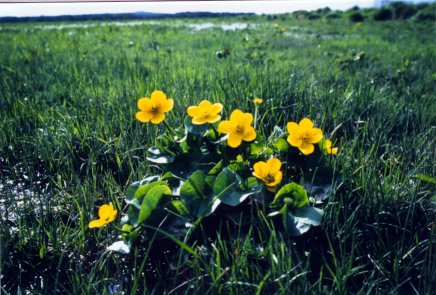Caragh is in North Kildare
and so we are never far away from a canal. The Grand
Canal cuts through
the parish joining Dublin to the River Shannon. In fact, the canal reaches its
highest point here, flowing both east to Dublin at Gary’s Lock and west to the
Shannon at Ballyteague Lock. It can do this because there is a strong flow of
water into the main canal from Pollardstown Fen via the Milltown feeder canal.
The towpaths have been well maintained in recent years by the Office of Public
Works. They now provide easy access for fishermen and long or short walks for
the more active.
 As the canals were
built in the 18th century the plant life or flora is well developed. A walk
along any towpath is well rewarded by the presence of the wild flowers. Watch
out for yellow iris, cuckoo flower, marsh marigolds,
As the canals were
built in the 18th century the plant life or flora is well developed. A walk
along any towpath is well rewarded by the presence of the wild flowers. Watch
out for yellow iris, cuckoo flower, marsh marigolds,  yellow water lily, marsh
valerian, hemp agrimony, purple loose strife, common spotted orchid, cowslips,
meadow sweet, great willowherb and many more. In the early autumn the tall reeds
show off their reddish brown heads of grass.
yellow water lily, marsh
valerian, hemp agrimony, purple loose strife, common spotted orchid, cowslips,
meadow sweet, great willowherb and many more. In the early autumn the tall reeds
show off their reddish brown heads of grass.
 The last ice age,
about 10,000 years ago, cut out many shallow lakes which developed into our
present day bogs e.g. the bog at Oldtown. It was also responsible for the deep
beds of gravel, which are a feature of Co. Kildare. The parish church in Caragh
is built over one such gravel bed. This is obvious from the wild flowers growing
on the church grounds. Fertilizers have never been used here and so the wild
flowers are able to grow naturally e.g. plantain, ox-eye daisy; self heal,
Lady's bedstraw and even some orchids, the common spotted and the bright red
pyramidal orchid. These flowers are a feature of dry sandy or gravel soil.
The last ice age,
about 10,000 years ago, cut out many shallow lakes which developed into our
present day bogs e.g. the bog at Oldtown. It was also responsible for the deep
beds of gravel, which are a feature of Co. Kildare. The parish church in Caragh
is built over one such gravel bed. This is obvious from the wild flowers growing
on the church grounds. Fertilizers have never been used here and so the wild
flowers are able to grow naturally e.g. plantain, ox-eye daisy; self heal,
Lady's bedstraw and even some orchids, the common spotted and the bright red
pyramidal orchid. These flowers are a feature of dry sandy or gravel soil.
Fr. Jackie O'Connell
P.P.
Dec. 1999
(To see more pictures of the flowers mentioned below, click on the "Flora Gallery"
button to the left.)![]()